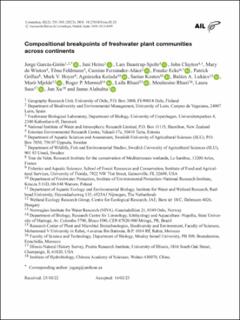| dc.contributor.author | García-Girón, Jorge | |
| dc.contributor.author | Heino, Jani | |
| dc.contributor.author | Baastrup-Spohr, Lars | |
| dc.contributor.author | Clayton, John | |
| dc.contributor.author | de Winton, Mary | |
| dc.contributor.author | Feldmann, Tõnu | |
| dc.contributor.author | Fernández-Aláez, Camino | |
| dc.contributor.author | Ecke, Frauke | |
| dc.contributor.author | Grillas, Patrick | |
| dc.contributor.author | Hoyer, Mark V. | |
| dc.contributor.author | Kolada, Agnieszka | |
| dc.contributor.author | Kosten, Sarian | |
| dc.contributor.author | Lukács, Balázs A. | |
| dc.contributor.author | Mjelde, Marit | |
| dc.contributor.author | Mormul, Roger P. | |
| dc.contributor.author | Rhazi, Laila | |
| dc.contributor.author | Rhazi, Mouhssine | |
| dc.contributor.author | Sass, Laura | |
| dc.contributor.author | Xu, Jun | |
| dc.contributor.author | Alahuhta, Janne | |
| dc.date.accessioned | 2023-11-14T13:14:33Z | |
| dc.date.available | 2023-11-14T13:14:33Z | |
| dc.date.created | 2023-09-20T15:22:24Z | |
| dc.date.issued | 2023 | |
| dc.identifier.citation | Limnetica. 2023, 42 (2), 291-301. | en_US |
| dc.identifier.issn | 0213-8409 | |
| dc.identifier.uri | https://hdl.handle.net/11250/3102489 | |
| dc.description.abstract | Unravelling patterns and mechanisms of biogeographical transitions is crucial if we are to understand compositional gradients at large spatial extents, but no studies have thus far examined breakpoints in community composition of freshwater plants across continents. Using a dataset of almost 500 observations of lake plant community composition from six continents, we examined, for the first time, if such breakpoints in geographical space exist for freshwater plants and how well a suite of ecological factors (including climatic and local environmental variables) can explain transitions in community composition from the subtropics to the poles. Our combination of multivariate regression tree (MRT) analysis and k-means partitioning suggests that the most abrupt breakpoint exists between temperate to boreal regions on the one hand and freshwater plant communities harbouring mainly subtropical or Mediterranean assemblages on the other. The spatially structured variation in current climatic conditions is the most likely candidate for controlling these latitudinal patterns, although one cannot rule out joint effects of eco-evolutionary constraints in the harsher high-latitude environments and post-glacial migration lags after Pleistocene Ice Ages. Overall, our study supports the foundations of global regionalisation for freshwater plants and anticipates further biogeographical research on freshwater plant communities once datasets have been harmonised for conducting large-scale spatial analyses. | en_US |
| dc.language.iso | eng | en_US |
| dc.publisher | Asociación Ibérica de Limnología (AIL) | en_US |
| dc.rights | Navngivelse-Ikkekommersiell 4.0 Internasjonal | * |
| dc.rights.uri | http://creativecommons.org/licenses/by-nc/4.0/deed.no | * |
| dc.title | Compositional breakpoints of freshwater plant communities across continents | en_US |
| dc.title.alternative | Puntos de inflexión en los gradientes de composición de las comunidades de plantas acuáticas de diferentes continentes | en_US |
| dc.type | Peer reviewed | en_US |
| dc.type | Journal article | en_US |
| dc.description.version | publishedVersion | en_US |
| dc.rights.holder | © 2023 The Authors | en_US |
| dc.source.pagenumber | 291-301 | en_US |
| dc.source.volume | 42 | en_US |
| dc.source.journal | Limnetica | en_US |
| dc.source.issue | 2 | en_US |
| dc.identifier.doi | 10.23818/limn.42.21 | |
| dc.identifier.cristin | 2177247 | |
| cristin.ispublished | true | |
| cristin.fulltext | original | |
| cristin.qualitycode | 1 | |

